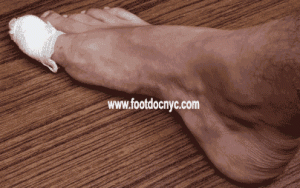As we discussed last week in our post about when to see a podiatrist for ingrown toenails, ingrown toenails are a painful side effect of wearing ill-fitting shoes or cutting your toenail too short. In this week’s post, we will examine the ingrown toenail removal options and learn about recovery. You will also find out about what you can expect if you have to have your ingrown toenail removal procedure done.
Surgical Ingrown Toenail Removal: Options
 Surgical treatment for an ingrown toenail is a common and rather simple operation at NYC Podiatry Center of Excellence. In fact, we perform 10,000+ of these procedures a year. That said, there are many different ways a podiatrist might attempt to correct the problem. Your foot doctor may choose to perform:
Surgical treatment for an ingrown toenail is a common and rather simple operation at NYC Podiatry Center of Excellence. In fact, we perform 10,000+ of these procedures a year. That said, there are many different ways a podiatrist might attempt to correct the problem. Your foot doctor may choose to perform:
- Partial removal of the nail
- Complete removal of the nail
- Removal of a portion of the underlying nail bed
- Removal of some soft tissue around the nail
Whatever ingrown toenail removal options your podiatrist decides to do, the ultimate goal will be to stop the nail edge from growing into the side of your toe. If your toenail continually becomes ingrown even after a few treatments, your doctor may ask if you want to have the portion of the nail permanently removed.
In a routine removal of part of the toenail, the foot doctor starts out by placing a small tourniquet around your toe. This is done in order to prevent anesthesia from moving throughout your foot, and to ensure that your toe is numb during the procedure. After the tourniquet is in place, the podiatrist administers anesthesia with an injection. Once the numbing is felt, your doctor takes uses surgical scissors to cut away the ingrown part of your toenail. Most often this is done by cutting a straight line down your nail. In most cases, 70% of the original nail is left intact. Special acid may need to be placed on the matrix area to avoid regrowth (if permanent removal is decided upon).
The procedure is often painless due to the anesthesia. Only pain felt is due to anesthesia injection. You may feel slight pressure as the surgeon cuts your nail. If you feel any pain other than light pressure, tell your podiatrist so that he injects more anesthesia, or simply wait for the numbness to kick in.
Surgical Ingrown Toenail Removal: Post-Op Protocol
At NYC Podiatry Center of Excellence, we provide you with important instructions on post-op care for your toenail. Your nail is there to prevent infections from setting in, and when a portion of the nail is removed, you are more susceptible to infections. That is why you will need to do what the doctor asks to help avoid any complications.
You will need to soak you foot for a few minutes a couple of times a day. Afterwards, you will need to dry your foot and clean away any blood or debris. You will need to avoid socks or closed toe shoes for a few days. Our podiatrists will provide you with complete instructions from start-to-finish so that you have a successful recover from ingrown toenail removal.
Thousands of Procedures Done Every Year in Our Center!
We are the EXPERTS in ingrown toenail procedures. We see thousands of patients for this painful condition and have learned to perform it painfully and successfully. Patients travel to us from all five NYC boroughs and Tri-State NYC area just to get their ingrown toenails treated. Should you wish to make an appointment, feel free to call us at (212) 288-3137 or make an appointment online.
- Podiatrist that does Telemedicine / Video Calls - March 28, 2020
- Podiatrists Accept EmblemHealth and GHI Insurance Plans - October 11, 2018
- NYC’s Celebrity Podiatrist for film, entertainment, athletic and modeling industries - September 20, 2018





